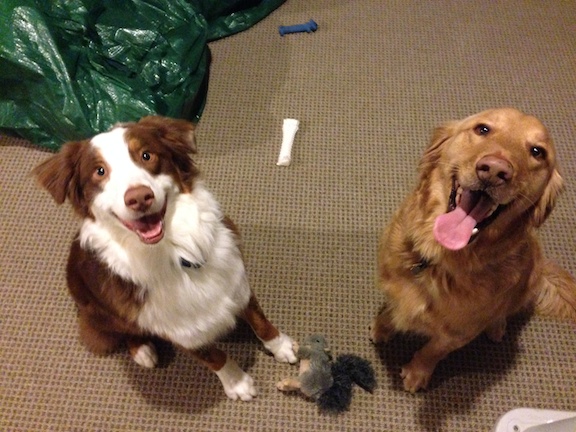Teaching Rigley to Calm Down So Sam Can Focus
By: David Codr
Published Date: February 7, 2014
 Meet Rigley (left) and Sam. Sam has been with his family for years while Rigley was only added to the pack last year.
Meet Rigley (left) and Sam. Sam has been with his family for years while Rigley was only added to the pack last year.
Their owner called me to help get Rigley to calm down and listen better while helping Sam respect their personal space and focus better.
When I arrived for the session, both dogs met me excitedly at the door but it was obvious that Rigley was the higher energy dog. When multiple dogs live in the home, they will try to elevate their energy level to match the dog with the highest energy. This can become a chain reaction of excitement. When you combine that with dogs who don’t have the best manners or a lot of practice restraining themselves you can end up with a very hectic household.
I showed their owners an exercise that will help both dogs with their issues. I started out with Rigley who only took three repetitions before he fully understood what I was asking from him. After coaching the members of the family through the exercise, we repeated it with Sam. Sam took about five minutes to complete the exercise the first time, but after that he got it.
The exercise will help Rigley learn to restrain himself and teach Sam to focus. I suggested that all the members of the family practice the exercise with both dogs daily for the next week or two. Because both dogs responded so quickly to the exercise, it should be easy for the family to master it with their dogs. Once that takes place, Sam’s ability to focus will be much sharper and Rigley will be better equipped to restrain himself.
Because Rigley was the higher energy and more mischievous of the two dogs, I showed their owner a technique to use whenever his energy level got too high. Many dog owners assume that excitement is akin to happiness, but these are not mutually exclusive. A dog can be calm and happy and I have found this is a better demeanor for both the dog and the owner.
I suggested that their owner use a leash and introduce a “time-out” anytime that Riggley’s energy level got too high. As the family includes two pre-teen children the mother chuckled when I mentioned a doggy time out. But stopping a dog and introducing a time out as soon as it gets too excited, we are able to help the dog understand that over excitement equals quiet time on the leash, while calm balanced behavior results in freedom. It will take a little time, but if Rigley’s owners consistently give him a time out when he gets all revved up, he will learn to embrace a calmer demeanor.
Because the dogs didn’t consistently come on command, I went over a recall exercise to help condition the dogs to the concept that coming when called is a good thing. All the members of the family took part in the exercise with both dogs individually. As soon as the dogs realized that they received a reward and attention / affection from their owners when they responded, they started running over each time anyone called them.
Next I went over the concept of escalating consequences. I like to have a set group of consequences to use whenever a dog exhibits an unwanted behavior or breaks the rules. By consistently utilizing these consequences with good timing anytime the dog gets out of line, we are able to communicate what is and is not allowed.
By the end of the session, their owner commented on the dog’s being more responsive and respectful of their personal space. I explained that by continuing the techniques and exercises consistently for a week, the dogs will adapt to this new behavior permanently.
Categorized in: Dog Behavior, Dog Psychology, Dog Training Omaha, Omaha dog training



